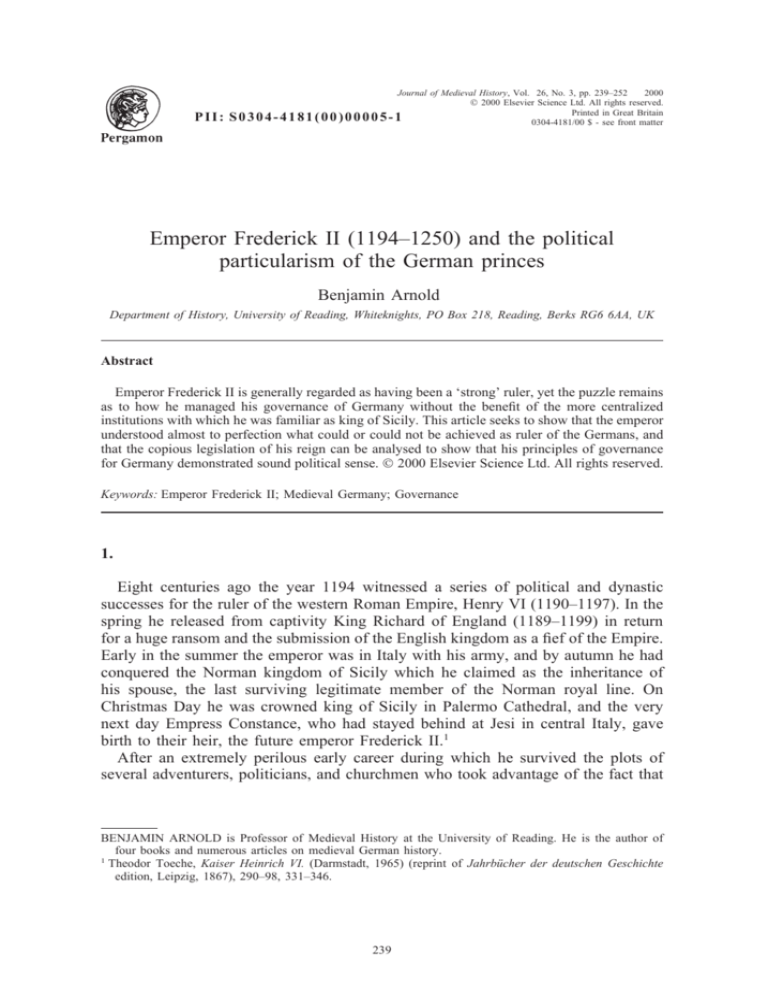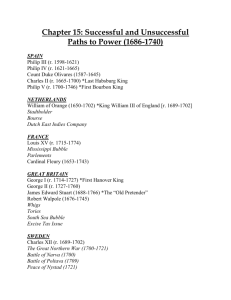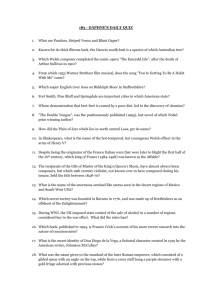
PII:
Journal of Medieval History, Vol. 26, No. 3, pp. 239–252
2000
2000 Elsevier Science Ltd. All rights reserved.
Printed in Great Britain
S0304-4181(00)00005-1
0304-4181/00 $ - see front matter
Emperor Frederick II (1194–1250) and the political
particularism of the German princes
Benjamin Arnold
Department of History, University of Reading, Whiteknights, PO Box 218, Reading, Berks RG6 6AA, UK
Abstract
Emperor Frederick II is generally regarded as having been a ‘strong’ ruler, yet the puzzle remains
as to how he managed his governance of Germany without the benefit of the more centralized
institutions with which he was familiar as king of Sicily. This article seeks to show that the emperor
understood almost to perfection what could or could not be achieved as ruler of the Germans, and
that the copious legislation of his reign can be analysed to show that his principles of governance
for Germany demonstrated sound political sense. 2000 Elsevier Science Ltd. All rights reserved.
Keywords: Emperor Frederick II; Medieval Germany; Governance
1.
Eight centuries ago the year 1194 witnessed a series of political and dynastic
successes for the ruler of the western Roman Empire, Henry VI (1190–1197). In the
spring he released from captivity King Richard of England (1189–1199) in return
for a huge ransom and the submission of the English kingdom as a fief of the Empire.
Early in the summer the emperor was in Italy with his army, and by autumn he had
conquered the Norman kingdom of Sicily which he claimed as the inheritance of
his spouse, the last surviving legitimate member of the Norman royal line. On
Christmas Day he was crowned king of Sicily in Palermo Cathedral, and the very
next day Empress Constance, who had stayed behind at Jesi in central Italy, gave
birth to their heir, the future emperor Frederick II.1
After an extremely perilous early career during which he survived the plots of
several adventurers, politicians, and churchmen who took advantage of the fact that
BENJAMIN ARNOLD is Professor of Medieval History at the University of Reading. He is the author of
four books and numerous articles on medieval German history.
1
Theodor Toeche, Kaiser Heinrich VI. (Darmstadt, 1965) (reprint of Jahrbücher der deutschen Geschichte
edition, Leipzig, 1867), 290–98, 331–346.
239
240
Benjamin Arnold
he had lost both parents by the age of four,2 this child turned into one of the most
admired and hated of all the powerful rulers in thirteenth-century Europe,3 whose
political grasp of, and professional application to his rights, duties, and inheritances
certainly matched the expertise of his contemporaries such as Louis IX of France
(1226–1270), Ferdinand III of Castile (1217–1252), and Jaime I of Aragon (1213–
1276).
By 1986 the German scholar Carl Willemsen had completed his catalogue of over
2,000 titles of books, articles, and other material mostly published since 1850 about
Frederick II and his immediate descendants.4 So it may appear presumptious to offer
yet another paper on the subject of this ruler. The motive is to examine one aspect
alone of Frederick II’s energetic career which is under-represented in the literature;
his political management of the German kingdom to which he was re-elected in 1211
and 1212, the kingdom which his family, the Staufen ducal dynasty from Swabia,
had considered theirs by right ever since the demise of their imperial forbears, the
Salians, in 1125.5
Modern historians generally regard Frederick II’s father and grandfather, Henry
VI and Frederick I Barbarossa (1152–1190) as successful rulers of Germany6 and
we know that Frederick II specifically appealed to their example, legacy, and memory
in his own political and administrative management of the German kingdom.7 Yet
Frederick II’s own reign is often regarded as the end of the road for the Staufen
version of German royal governance because the kingdom collapsed under papal
pressure into civil conflicts and rival royal elections in the 1240s: the Staufen dynasty
lost the throne, its fisc, and most of its political support in the 1250s: and then it
was virtually exterminated by Charles of Anjou, the new king of Sicily (1266–1285)
in the 1260s.8 Why was it that so powerful a figure as Frederick II was eventually
betrayed by his own princes and bequeathed little more than memories to Rudolf of
Habsburg, who reigned in Germany from 1273 to 1291, and considered himself to
be the political heir of his mentor Frederick II, of Staufen governance, and of the
Staufen duchy of Swabia?9
There are at least three major problems which need to be considered in explaining
2
David Abulafia, Frederick II. A medieval Emperor (London, 1988), 93.
General guidance from Wilhelm Koch and Hans Martin Schaller, ‘Friedrich II.’ with bibliography in Lexikon
des Mittelalters, ed. R.-H. Bautier etc., vol. 4 (Munich and Zurich, 1989), cols. 933–939.
4
Carl A. Willemsen, Bibliographie zur Geschichte Kaiser Friedrichs II. und der letzten Staufer, Monumenta
Germaniae Historica (hereafter MGH), Hilfsmittel vol. 8 (Munich, 1986).
5
See Klaus Schreiner, ‘Die Staufer als Herzöge von Schwaben’, in: Die Zeit der Staufer, Geschichte, Kunst,
Kultur, Katalog der Ausstellung im wüttembergisches Landesmuseum Stuttgart, vol. 3 (Stuttgart, 1977),
7–19.
6
E.g. the assessment in Horst Fuhrmann, Germany in the High Middle Ages c. 1050–1200, transl. Timothy
Reuter, Cambridge Medieval Textbooks (Cambridge, 1986), 135–86.
7
E.g. in Constitutiones et acta publica imperatorum et regum, ed. Ludwig Weiland, MGH Legum iv, vol. 2
(Hanover, 1896), no. 71, p. 83 (1220), no. 196, p. 243, (1235), no. 204, p. 274 (1236), and no. 260, p.
357 (1245).
8
Abulafia, Frederick II, 375–428.
9
Oswald Redlich, Rudolf von Habsburg. Das deutsche Reich nach dem Untergange des alten Kaisertums
(Aalen, 1965) (reprint of the Innsbruck, 1903 edn.), 127: Rudolf war nicht bloss Friedrichs II. treuer Vasall
gewesen, sondern auch sein Schüler.
3
Emperor Frederick II (1194–1250) and the political particularism of the German princes
241
the achievements and limitations of Frederick II’s rule over Germany. The first is
raised by the fact that he was, after 1220, an absentee king. He arrived in Germany
in 1212 to fight a civil war with Emperor Otto IV (1198–1214), who had seized
control from the Staufen upon Philip of Swabia’s assassination in 1208.10 He had
established his claim by 1215 when he was re-crowned at Aachen as rex Romanorum,
or King of the Romans, the official title of the German ruler since the late eleventh
century.11 He worked diligently to restore the prerogatives and possessions of the
crown, as Wilhelm Stürner’s fine new study of Frederick’s early years adequately
demonstrates from the sources.12 But Frederick was more than a German king.
Throughout his career he was convinced that God had called him to fulfil the duties
and ambitions of his imperial progenitors:13 to rescue Jerusalem from the authority
of the sultans of Egypt; to govern his Italian and Sicilian kingdoms as well as Germany and Burgundy; to assume the imperial crown and title as the leading ruler in
Christendom; and in cherishing true religion and the Catholic Church, to offer the
necessary counterweight to the new temporal ambitions of the papacy with its growing monarchical tendency in European affairs.14
In 1220 Frederick II therefore left for Rome and his imperial coronation, and
thereafter regarded his rich Sicilian kingdom as the realistic basis for all his operations as crusader, emperor, and rival of the papal curia.15 As we shall see, the
emperor revisited Germany twice between 1235 and 1237 when a new political settlement was worked out after the rebellion of his heir. It is easy to see why the
emperor’s complex aims turned him into an absentee ruler of Germany. Later we
shall have to decide whether this was a genuine source of political weakness, given
the peculiar structure of the German realm. It may be of value to draw a comparison
here with the English kingdom. Until the best part of their Norman and Angevin
dominions were lost to the king of France in 1204, the kings of England spent
very much of their reigns absent from the island without perceptibly diminishing the
authority of the crown and the expansion of its business.16 It is true that regal institutions in Germany and England were different, but the point is that English royal
authority does not seem to have been enervated by absentee kings.
The second problem to be addressed is whether Frederick II, his advisers, and the
regents to whom he delegated the powers of the German crown made specific mis10
Bernd Ulrich Hucker, Kaiser Otto IV., MGH Schriften, vol. 34 (Hanover, 1990), 291–357, on the downfall
of Otto IV.
Abulafia, Frederick II, 120–122.
12
Wilhelm Stürner, Friedrich II., Teil I, Die Königsherrschaft in Sizilien und Deutschland 1194–1220, Gestalten
des Mittelalters und der Renaissance (Darmstadt, 1992), 195–227.
13
E.g. Constitutiones ed. Weiland, ii, no. 270, p. 378 (1248) has …ex imperialis officii nostri debito, quod ex
celesti dispensacione suscepimus… On Frederick II’s conception of his office, see Hans Martin Schaller,
‘Die Kaiseridee Friedrichs II.’, in: Probleme um Friedrich II., ed. Josef Fleckenstein, Vorträge und Forschungen, vol. 16 (Sigmaringen, 1974), 109–134.
14
See Colin Morris, The Papal Monarchy. The Western Church from 1050 to 1250, Oxford History of the
Christian Church (Oxford, 1989), 559–568.
15
Abulafia, Frederick II, 132–63, 202–225, 321–74.
16
See the remarks of John Le Patourel in ‘The Plantagenet Dominions’, History, 50 (1965), 295, note 14 and
of W. L. Warren in The Governance of Norman and Angevin England 1086–1272, The Governance of
England, vol. 2 (London, 1987), 80, 101.
11
242
Benjamin Arnold
takes in their handling of German politics. From 1212 right through to the late 1240s
the German royal court issued a remarkable series of varied legislative acts, privileges, and Landfrieden, some in Frederick’s name and some in the names of his
sons.17 In the light of this rich body of material, we need to consider the proposal
which has not died out of modern historiography: that these acts contained too many
concessions of royal rights and prerogatives to the prelates of the German Church,
to the secular princes whose local jurisdictions were in any case so powerful in
Germany, and in some cases, to the more formidable German cities whose commerce
and political strength were growing rapidly in the thirteenth century. In other words,
it is possible that Frederick II was enmeshed by his inheritances, ambitions, and
expectations in an international scheme of politics which meant that the German
princes, bishops, and cities had to be steadied by material concessions while the
absentee emperor fought or negotiated with sultans and Saracens, popes and cardinals, rebellious Sicilians and fractious Lombards. If the court ever did intend to buy
German political support in that manner, then it was much too expensive. Excommunicated by Pope Gregory IX (1227–1241) in 1239, the emperor’s German archbishops turned against him in 1241, and thereafter the kingdom knew no peace until
the advent of Rudolf of Habsburg as king in 1273. But is it really the case that the
body of acta issued by the court carry the stigma of political concession, or would
that be a mistaken reading of their content and intention?
The third problem is perhaps even harder to elucidate. If Frederick II had attempted
to introduce into Germany those organs of royal governance with which he was
familiar in Sicily,18 then would he have moved the German kingdom onto that path
towards royal centralization which historians like to detect in thirteenth-century
England and France?19 If the emperor ever did entertain such schemes, then he would
have had to reckon with the local powers and rights of the princes both lay and
ecclesiastical, whose own jurisdictions had become much more entrenched in Germany on a territorial basis ever since the War of Investitures (1076–1122).20 In other
words, did Frederick II possess the rights and powers as king of the Romans, overlord
of the imperial princes, and possessor of a rich fisc,21 to reverse German particularism, that is, the practical sharing of governing power between crown and princes
17
Apart from direct access to the texts in Constitutiones, ed. Weiland, ii, pp. 54–449, see the commentary in
the papers of Ernesto Sestan, Erich Klingelhöfer, Erich Schrader, and Ernst and Otto Schönbauer, edited
by Gunther Wolf in Stupor mundi. Zur Geschichte Friedrichs II. von Hohenstaufen, Wege der Forschung
vol. 101 (Darmstadt, 1966), 331–41, 396–454, as an introduction to the subject.
18
See David Abulafia’s excellent elucidation of Frederick II’s register for 1239–1240 in his Frederick II,
321–339.
19
See the extreme statement of Georges Duby in his France in the Middle Ages 987–1460. From Hugh Capet
to Joan of Arc, transl. Juliet Vale (Oxford, and Cambridge, Mass, 1991), 298: ‘I would argue that the various
elements that constituted the political system in France until the end of the ancient régime were all in place
at the death of Philip Augustus.’
20
Benjamin Arnold, Princes and territories in medieval Germany (Cambridge, 1991), 61–73, 152–233, for
discussion of these problems.
21
Ekkehard Kaufmann, ‘König’ and M., Merberger, ‘Krongut’, in: Handwörterbuch zur deutschen Rechtsgeschichte, vol. 2, eds. Adalbert Erler and Ekkehard Kaufmann (Berlin, 1978), cols. 999–1023, 1217–29.
Emperor Frederick II (1194–1250) and the political particularism of the German princes
243
which goes back to the refounding of the western Empire by Otto the Great (936–
973) in 962?
The German magnates were so well equipped with economic, jurisdictional, and
military resources and opportunities, all of which were phenomenally expanded during the twelfth and thirteenth centuries that such a reversal could never have been
undertaken.22 Instead, Frederick II successfully enriched his fisc and took up the
traditional political task of managing enough of the principes imperii into a party
which would support his dynasty.23 This worked well, perhaps as late as 1245 when
Pope Innocent IV (1243–1254) took the revolutionary decision to crush the Staufen
for good, and the German bishops, always unreliable, staged a new election in 1246.
So the easiest way to explain German political particularism in relation to Frederick II’s reign is simply to accept that power sharing was a tradition founded in the
ninth and tenth centuries, and that the local autarky of scores of bishops and secular
princes could not be overturned by a king. As Wolfgang Petke has rightly asserted,
‘On the basis of its actual ascendancy, the aristocracy had made good its pretensions
to shared rule ever since Frankish times.’24 Frederick II used the political loyalty
and practical jurisdictions of such an aristocracy to support his kingly duty of
imposing peace, order, and justice upon the German realm. This is shown clearly in
the imperial Landfriede issued at Mainz in 1235, which explicitly enjoins the princes
as loyal vassals to exercise their own jurisdictions in their own localities: ‘… that
our princes and all others who hold juridical power directly from us will determine
the cases tried before them according to the reasonable custom of their lands by just
judgement, and that they will enjoin the same upon all judges who are under them
and hold jurisdiction from them.’25
Frederick II was a German king in the style of his father and grandfather in that
the princes could be managed, but that their local jurisdictional authority could not
be taken away from them. When Edward I of England (1272–1307) insisted upon
the programme of quo warranto, then he was dealing with about a dozen earls.26
How could Frederick II have brandished the same idea before scores of German
dukes, margraves, and counts? In his Sicilian kingdom he might do so, but not in
Germany. This still leaves unanswered the question of why rule by the Staufen dynasty, if Frederick II had done for Germany all that could be expected of him, collapsed in the 1240s and 1250s, the emperor’s death in 1250 being given currency
and with some justification as the end of an era in history books and university
syllabuses. I believe two answers can be given.
22
Abulafia, Frederick II, 125.
See, for example, their impressive turnout for the election of Conrad IV in 1237: Constitutiones, ed. Weiland,
ii, no. 329, p. 440.
24
Kanzlei, Kapelle und Königliche Kurie unter Lothar III (1125–1137), Forschungen zur Kaiser- und Papstgeschichte des Mittelalters. Beihefte zu J. F. Böhmer, Regesta Imperii, vol. 5 (Cologne and Vienna, 1985), 100.
25
Constitutione, ed. Weiland, ii, no. 196 (ch. 4), pp. 242f.
26
See K. B. McFarlane, The Nobility of Later Medieval England. The Ford Lectures for 1953 and related
studies, (Oxford, 1973), 249–52 and Chris Given–Wilson, The English nobility in the late middle ages, The
fourteenth-century political community (London and New York, 1987), 29–31. On the process, see Donald
W. Sutherland, Quo Warranto Proceedings in the Reign of Edward I 1278–1294 (Oxford, 1963).
23
244
Benjamin Arnold
The first is that the jurisdictional autarky of the princes was favoured by the crown
itself in the twelfth and thirteenth centuries in the interests of order and local peace,
but that the inevitable result was the territorial particularism of churchmen, lay
princes, and interstitial cities which persisted until modern times. We have just seen
that Frederick II enjoined juridical duties upon the princes and their own magistrates
in 1235 under the aegis of the imperial Landfriede, and this simply underlined the
edicts of 1231 and 1232 which confirmed that ‘Each and every prince shall enjoy
unmolested the liberties, jurisdictions, counties, and Zentgerichte (hundredal courts)
freely owned by, or enfeoffed to him, according to the approved custom of his
land.’27 This testifies to the jurisdictional aspect of power sharing which crown and
aristocracy took for granted, and continues the known policy of Frederick II’s grandfather in this respect. Significant legislation against incendiarism during feuds was
issued by Frederick Barbarossa at Nuremberg in 1186 or 1188 in which the dukes,
margraves, counts palatine, landgraves and all lesser counts were specifically
enjoined to sentence arsonists iusticiae suae auctoritate, by the power of their own
jurisdiction, using either the testimony of seven witnesses or simply the notoriety of
the accused, and to execute them forthwith.28
In other words, the capital jurisdiction of the princes was well in place by the
1180s, and there are earlier texts such as the grant of the East Franconian ducatus
to the bishops of Würzburg in 1168 which also confirm this right of vindicta sanguinis.29 We also know that the practical effectiveness of princely jurisdiction made
great strides under Frederick II’s patronage. In a revealing chapter of King William
of Holland’s (rex Romanorum, 1247–1256) Landfriede confirmation of 1255, all the
jurisdictions of the princes were confirmed so that the inhabitants of them should
submit just as ‘they and their progenitors have rightly been accustomed to do for
the last thirty or forty or fifty years’.30
The second answer arises from the fact that the political, diplomatic, and military
potential of the papacy reached its zenith during the thirteenth century,31 and we
should not underestimate the determination of Pope Innocent IV and his successors32
to do away with the Staufen as a ruling house.33 The Salian emperors had survived
sentences of excommunication and deposition at the hands of Pope Gregory VII
(1073–1085) and his successors. King John of England (1199–1216) was prudent
enough to submit to the demands of Pope Innocent III (1198–1216). But Emperor
27
Constitutiones, ed. Weiland, ii, no. 304, p. 419 (1231) and no. 171, p. 212 (1232).
Constitutiones, ed. Weiland, ii, no. 3l8 (chs. 2 & 13), 449–52. See E. Wadle, ‘Der Nürnberger Friedebrief
Kaiser Friedrich Barbarossas und das gelehrte Recht’, in: Wege europäische Rechtsgeschichte. Karl Kroeschell zum 60. Geburtstag, ed. G. Köbler, Rechtshistorische Reihe, vol. 60 (Frankfurt am Main, 1987), 548–572.
29
Die Urkunden Friedrichs I. 1168–1180, ed. Heinrich Appelt et al. MGH Diplomata, vol. 10, part iii (Hanover,
1985), no. 546, pp. 3–7 (1168). See Arnold, Princes, 101 and note 66, pp. 104f. and notes 85 and the
literature cited there.
30
Constitutiones, ed. Weiland, ii, no, 375, pp. 477f. On King William’s important relation to the Landfriede
See Heinz Angermeier, Königtum und Landfriede im deutschen Spätmittelalter (Munich, 1966), 33–53.
31
Morris, Papal Monarchy, 568–582.
32
On them and their policies, see J. N. D. Kelly, The Oxford Dictionary of Popes (Oxford and New York,
1986), 192–197.
33
See D. J. A. Matthew, ‘Reflections on the Medieval Roman Empire’, History, 77 (1992), especially 381–389.
28
Emperor Frederick II (1194–1250) and the political particularism of the German princes
245
Otto IV (1198–1214, d. 1218) could not survive the withdrawal of the same pope’s
political and moral support, and the Staufen could not in the end survive the decree
of irrevocable deposition adopted by the First Council of Lyons in 1245,34 although
it took more than twenty years effectively to eradicate the dynasty from Germany
and Italy.
2.
Now we need to return to the problem of Frederick II as an absentee ruler from
his German kingdom. The fact is that his predecessors as far back as Otto the Great
in the tenth century generally passed a great deal of their time in Italy and Burgundy
in the style of medieval peripatetic kingship.35 Although he liked Apulia and built
residential castles there,36 Frederick II was no stay at home either. When he did
reside in Germany between 1212 and 1220, the iter as an adjunct of the royal ruling
method did not weaken his hand. Frederick II was already a prudent ruler under
whom some of the administrative procedures beloved of constitutional historians
were carried out effectively. The few surviving instruments have been taken to demonstrate this.37 They include the writ appointing Gerhard of Sinzig, an imperial ministerialis, as procurator of some of the royal fisc on the Rhine and the Mosel in 1216.38
Also of importance is the survey, usually dated 1214, of the imperial officium of
Neuburg on the Danube as administered by the marshals of Kalden–Pappenheim.39
There were also issued a number of privileges to protect the legal and economic
status of towns situated upon the royal fisc. Notable examples were received by
Goslar in Saxony and Nuremberg in Franconia, both dated 1219.40 Another survival
is the list of assets to be recovered for the imperial officium of Pfullendorf in Swabia.41 This process of rebuilding the fisc after the civil wars of 1198 to 1214 went
on long after Frederick’s departure for Italy in 1220. A recent remarkable study by
a young German scholar, Andreas Christoph Schlunk,42 reveals that by 1240 the
crown was almost as rich in fiscal resources, towns, castles, enfeoffed retinues, mon-
34
See Constitutiones, ed. Weiland, ii, nos. 339–401, pp. 507–516.
There exists a long and interesting literature on the German royal iter. For a summary, see Arnold, Princes,
47–51, and the references cited there.
36
Carl A. Willemsen, ‘Die Bauten Kaiser Friedrichs II. in Süditalien’, in: Die Zeit der Staufer vol. 3, 143–163.
37
Stürner, Friedrich II., 195–217.
38
Constitutiones, ed. Weiland, ii, no. 55, pp. 66f.
39
Wilhelm Kraft, Das Urbar der Reichsmarschälle von Pappenheim, Schriftenreihe zur bayerischen Landesgeschichte, vol. 3, new edn. (Aalen, 1974).
40
Bernhard Diestelkamp, ‘Quellensammlung zur Frühgeschichte der deutschen Stadt’, in: C. van der Kieft and
J. F. Niermeijer, Elenchus fontium histtoriae urbanae, Acta collegii historiae urbanae societatis historicorum
internationalis, vol. 1 (Leiden, 1967), nos. 121–24, pp. 190–98 (1218–19).
41
Karl Schmid, Graf Rudolf von Pfullendorf und Kaiser Friedrich I., Forschungen zur oberrheinische Landesgeschichte, vo1. 1 (Freiburg im Breisgau, 1954), 297. The most accessible introduction to the problems raised
by such texts is by Wolfgang Metz in his Staufische Güterverzeichnisse. Untersuchungen zur Verfassungsund Wirtschaftsgeschichte des 12. und 13. Jahrhunderts (Berlin, 1964), esp. 77–97.
42
Königsmacht und Krongut. Die Machtgrundlage des deutschen Königtums im 13. Jahrhundert — und eine
neue historische Methode (Stuttgart, 1988).
35
246
Benjamin Arnold
asteries, ecclesiastical advocacies, manors, tolls, and all other rights, revenues, and
jurisdictions as it had ever been at any time since Frederick Barbarossa began a
forceful new programme of enriching the crown in the 1160s.43 So Frederick II’s
long absence from Germany after 1220 had not imperilled the ability of royal officials
to restore to the fisc the assets lost during the war years of 1198 to 1214.
As Roman emperor, crusader, king of Sicily, and suzerain of Lombardy, Frederick
II had good reason to absent himself to the south. At the time this was not considered
at all abnormal. It was an extension of a traditional institution, the iter or royal
perambulation, upon which German magnates would in any case visit him in Italy.44
As the emperor pointed out in the Mainz Landfriede of 1235, he could not be
expected to preside in person as the supreme magistrate of the royal court because
‘the government of the Empire and the affairs of diverse lands and regions cause
such cares as have always to be put right by our diligence’.45 In other words, the
ruler could not be everywhere at once, and this principle was repeated to the Styrians
in 1248 when Frederick appointed a captain-general over the duchy: the imperial
eye has to be cast over so many parts of the Empire that ‘we are unable to stay
continuously and in person in the duchy of Styria’.46
The emperor’s absence from the German kingdom was not good for his grip upon
its affairs notwithstanding such remarks. In 1225 his regent, Archbishop Engelbert
of Cologne, was assassinated during a feud with a member of his own kindred and
the next regent, Duke Louis I of Bavaria (1183–1231), proved so unreliable that he
had to be removed from office.47 For reasons which remain obscure, the emperor’s
son and heir Henry VII (1220–1235, d. 1242) went into revolt in 1234 and was
subsequently deposed.48 At papal instigation the ecclesiastical princes eventually
betrayed Frederick II in 1246 and elected as their king Henry Raspe, landgrave of
Thuringia, the traitor evidently believing that ‘we have raised shield and sword on
behalf the people of Christ for the reverence of God and Holy Mother Church’.49
The ‘enemy of Christ’, Frederick II, had been absent from Germany for less than
eight years.
When Frederick II did come back to Germany (that is, on two visits between 1235
and 1237), then the cards fell easily into his hands. In 1235 he removed his ungrateful
son. He celebrated a new marriage, with the king of England’s sister Isabella (d.
1241).50 The Welf heir, Otto the Child (1227–1252), who had prudently declined
Pope Gregory IX’s (1227–1241) offer of the German crown in 1229,51 was reconciled
43
Karl J. Leyser, ‘Frederick Barbarossa and the Hohenstaufen Polity’, Viator, 19 (1988), here 164–73.
E.g. Constitutiones, ed. Weiland, ii, no. 94, pp. 117f. (1223) at Capua or no. 187, pp. 228f. (1234) at Foggia.
Constitutiones, ed. Weiland, no. 196 (ch. 28), pp. 246f.
46
Constitutiones, ed. Weiland, no. 270, p. 378.
47
On their time in authority, see Thomas Curtis van Cleve, The Emperor Frederick II of Hohenstaufen. Immutator mundi (Oxford, 1972), 349–64.
48
Van Cleve, 365–76, and Abulafia, Frederick II, 229–42.
49
Dieter Hägermann and Jaap G. Kruisheer, Die Urkunden Heinrich Raspes und Wilhelms von Holland, MGH
Diplomata, vol. 18, part i (Hanover, 1989), no, 1, p. 30.
50
Abulafia, Frederick II, 239–44.
51
Hucker, Kaiser Otto IV., 382f.
44
45
Emperor Frederick II (1194–1250) and the political particularism of the German princes
247
for good by the creation for him of the duchy of Brunswick and Lüneburg.52 In 1236
Austria and Styria were temporarily taken into the imperial fisc; their legal privileges
were confirmed; and Vienna was declared an imperial city.53 In 1237 the emperor’s
next surviving legitimate son, Conrad IV (1237–1254), was elected king of the Romans.54 Frederick II’s great legislative achievement as German king, the Landfriede
of Mainz issued in 1235, was long remembered because it was was also circulated
in many vernacular versions.55 As the Cologne Annalist remarked, ‘the old laws
were stabilized; new ones were established and written down on parchment; and
they were published everywhere in German, Teutonico sermone.’56
3.
The medieval king was both guardian and servant of established law, but legal
historians have generally accepted that the revival of the study of Roman Law from
the twelfth century encouraged at royal courts a more positive attitude amongst the
kings’ legal advisers to proclaim new ordinances, that is, to turn the king into a
legislator or legum conditor, if not really in the style of Justinian the Great (527–
565), then in an echo of his purpose. In 1182, when Frederick Barbarossa confirmed
the privileges of the town of Speyer, his clerks deliberately included Justinianic
phraseology.57 Barbarossa’s impressive legislative programme constituted another
dynastic tradition which Frederick II was eager to follow. Like Alfonso X of Castile
(1252–1284) and Edward I of England, Frederick II has commonly been regarded
in modern historiography as a formidable legislator, his most notable exercise consisting of the Liber Augustalis or ‘Constitutions of Melfi’ promulgated for his Sicilian
kingdom in 1231.58 In his carefully crafted survey of German and imperial lawmaking entitled ‘Gesetzgebung’ (1970),59 Hermann Krause considers that the era of
Staufen legislation stretching from the Decrees of Roncaglia in 115860 to the Mainz
Landfriede of 1235 witnessed something like a transition of the German ruler from
52
Constitutiones, ed. Weiland, ii, nos. l97–99: pp. 263–66 (1235).
Karl Lechner, Die Babenberger. Markgrafen und Herzoge von Österreich 976–1246, Veröffentlichungen des
Instituts fur österreichische Geschichtsforschung, vol. 23 (Vienna, Cologne, and Graz, 1976), 282f., and
Peter Osendes, ‘Die Stadtrechtsprivilegien Kaiser Friedrichs II. für Wien’, Deutsches Archiv, 43 (1987),
110–134.
54
Constitutiones, ed. Weiland, ii, no. 329, pp. 439–41.
55
Constitutiones, ed. Weiland, ii, 196 & 196 A, pp. 241–63.
56
Chronica regia Coloniensis. Annales maximi Colonienses, ed. Georg Waitz, MGH Scriptores rerum Germanicarum in usum scholarum, vol. 18 (Hanover, 1880), 267.
57
Appelt, Urkunden Friedrichs I., no. 827, p. 34.
58
Hermann Conrad, Thea von der Lieck-Buyken and Wolfgang Wagner, Die Konstitutionen Friedrichs II. von
Hohenstaufen für sein Königreich Sizilien, Studien und Quellen zur Welt Kaiser Friedrichs II., vol. 2,
(Cologne and Vienna, 1973) and the English translation by James M. Powell, The Liber Augustalis or
Constitutions of Melfi 1231 (Syracuse, NY, 1971). We are cautioned against exaggerating the systematic
method and coherent presentation of the code by Donald Matthew in his The Norman Kingdom of Sicily,
Cambridge Medieval Textbooks (Cambridge, 1992), 185f., 342–44, 353, and by Abulafia in Frederick II,
202–14.
59
Handwörterbuch zur deutschen Rechtsgeschichte, i. cols. 1606–20.
60
Appelt, Urkunden Friedrichs I., nos. 237–42, pp. 27–36.
53
248
Benjamin Arnold
the defender of ancient right to a legislator, a legum conditor in the classical or
modern senses. If Frederick Barbarossa, Henry VI, and Frederick II, were incipient
legum conditores, then we need to ask whether the acta of Frederick II can credibly
be interpreted as elaborate devices for purchasing the support of the German princes.
It is usually accepted that Frederick II was well educated, literate, and intelligent,
an author of some insight, observation, and originality, perhaps outclassing in his
treatise on falconry, the De arte venandi cum avibus,61 the abilities of other
thirteenth-century royal authors, Jaime I of Aragon in his Book of Deeds and Alfonso
X of Castile in his Siete Partidas.62 However, Frederick II’s literacy and his reputed
mastery of several languages does not mean that the arengae and content of his
legislation were necessarily read by him or even read out to him. But it is hard to
believe that in such a long reign the imperial chancery could consistently have concealed concessionary implications (had they existed) of the acta from the emperor’s
eye. In itself the language of the legislation claims the opposite.63
We hold the monarchy with the title ‘Roman’ primarily of the Maker by whom
kings reign and princes hold their princedoms, and who has set our throne above
the peoples and kingdoms; and we are established in the wholeness of power. It
therefore befits Our Imperial Majesty not only to guard and maintain in their
ancient rights those by whom we obtained our supreme glory [i.e. the princes,
who had elected him king in the first place] and those in whom it consists, for
they were summoned with us to part of the care, and receive honour and glory
from our supremacy: but also, so far as equity allows and reason permits, to adorn
them honourably and fittingly with new and honourable gifts both of right and
of grace.
Heinrich Fichtenau has taught us to take such harangues much more seriously
than our distaste for such flowery expression might otherwise allow.64
If we bear in mind that the imperial court had always accepted the division of
jurisdictional power between crown, bishops, and secular princes, then such arengae
make perfect sense, and actually fit those injunctions of Frederick Barbarossa in
1186/88, Frederick II in 1235, and William of Holland in 1255 already cited,65 bid61
Johannes Fried, ‘Kaiser Friedrich II. als Jäger oder Ein zweites Falkenbuch Kaiser Friedrichs II.?’, Nachrichten der Akademie der Wissenschaften in Göttingen, i, phil.-hist, Klasse, vol. 4 (Göttingen, 1996); Intellectual
Life at the Court of Frederick II Hohenstaufen, ed. William Tronzo, Studies in the History of Art, vo1. 44
(Washington, 1994).
62
See Felipe Fernández–Armesto, Before Columbus. Exploration and Colonisation from the Mediterranean to
the Atlantic 1229–1492, Middle Ages Series (Philadelphia, 1987), 12, 15, 76f, and Jerry R. Craddock, ‘The
Legislative Works of Alfonso el Sabio’, in: Emperor of Culture. Alfonso X the Learned of Castile and his
thirteenth-century Renaissance, ed. Robert I. Burns, Middle Ages Series (Philadelphia, 1990), 182–197.
63
From Brian Pullan, Sources for the History of medieval Europe from the mid-eighth to the mid-thirteenth
century, (Oxford, 1971), 213.
64
On the content and meaning of the harangues, see Fichtenau’s Arenga. Spätantike und Mittelalter im Spiegel
von Urkundenformeln, Ergänzungsband der Mitteilungen des Instituts für österreichische Geschichtsforschung 18 (Graz and Cologne, 1957), 30–88, and F. Merzbacher, ‘Arenga’, in; Handwörterbuch zur deutschen Rechtsgeschichte, i, cols. 217i.
65
See above, notes 25, 28, 30.
Emperor Frederick II (1194–1250) and the political particularism of the German princes
249
ding the princes to exercise their own jurisdictions and enjoining the subjects of the
German kingdom to obey them.
In his short survey entitled ‘Fürstenprivilegien Friedrichs II’,66 Werner Goez holds
that the legislation of the first half of the thirteenth century is not concessionary in
content, tone, or intent, and cannot therefore have contributed to princely particularism in Germany. A number of scholars have been impressed that the imperial chancery was concerned instead to define the respective rights of the crown, the Church,
and the princes in more modern thirteenth-century terms, and in the light of the great
economic and jurisdictional advances made by all German landowners in the twelfth
century. In other words, the acta concern the rights of the three parties in their proper
relation to each other, not just the crown’s rights. The details include the scope and
limits of their law courts and the activities of their magistrates; the fiscal obligations
and the corveés of their servile dependents; the proper control of their towns and
the inhabitants; the status in law of tolls, mints, markets, roads, and fortifications;
the protection of lords’ ultimate proprietary rights over fiefs; and the correct exercise
of ecclesiastical advocacies, rights of protection over the Church.67 As crown officials
gradually recovered the imperial fisc in the years after 1212, both Frederick II and
Henry VII realized that their agents had often overstepped royal rights in the regions,
much to the annoyance of secular princes and churchmen whose assets were thereby
threatened. When such practices were forbidden in the legislation, then they could
be read as concessions, but they are concessions from strength. Far from the princes
encroaching upon the crown’s rights, the opposite appears to have been the case on
a large scale, as Henry VII admitted to Bishop Hermann of Würzburg in 1234. The
king wrote at length to his officials ordering them to desist.68 This echoes the tone
of Frederick II’s edict of Cividale in 1232, confirming Henry VII’s own enactment
of Worms in 1231, in which the court promised that royal officials would not abuse
or exceed their powers.69
If the legislation of Frederick II was not concessionary but cooperative, and even
drawn up from a position of relative political strength, then it did seek to define the
rights of the three parties in a comprehensive fashion. It sought to remove causes
of just complaint against royal agents. It sought to confirm the rightful jurisdictions
of the princes and the Church, powers which the crown intended to use, under the
aegis of the Landfriede and in its capacity as overlord of the principes imperii, in
the interests of justice and peace in Germany which was much too large to cover
by itinerant royal assizes. The enactments sought, finally, to modernize the relation
of royal and imperial authority to canon law in matters such as heresy prosecutions,
ecclesiastical courts and appeals, the renunciation of ius spolii, and the proper conduct of episcopal elections.70
66
Handwörterbuch zur deutschen Rechtsgeschichte, i, cols. 1358–61.
The actual content of these acta is examined comparatively in Arnold, Princes and territories, 205–09.
68
Constitutiones, ed. Weiland, ii, no. 324, p. 434.
69
Constitutiones, ed. Weiland, no. 304, pp. 418–20 (1231) and no. 171, pp. 211–13 (1232).
70
For these ecclesiastical matters see especially Constitutiones, ed. Weiland, ii, nos. 46–48, pp, 57–61 (1213)
and 73, pp. 86–91 (1220). There was not much new in them that Pope Innocent III had not in any case
agreed with Frederick II’s predeceesors. On ius spolii, see H.-J. Becker, ‘Spolienrecht’, in: Handwörterbuch
zur deutschen Rechtsgeschichte, iv, cols. 1779–1780.
67
250
Benjamin Arnold
My argument that the crown deliberately underlined and encouraged autarkic princely jurisdiction as a practical solution towards the problem of the German kingdom’s
lawlessness can be verified in Frederick II’s decisions about the duchy of Austria,
which was temporarily acquired for the imperial fisc in 1236.71 Here was a real
opportunity to abolish a strong, coherent, and autonomous princely jurisdiction
founded in 1156 in favour of a new magistracy under the crown. But Frederick II
was consistent in applying the opposite principle; the king was the guardian and
guarantor of efficacious regional jurisdictions in all their variety. In 1237 he went
to Austria and confirmed the local custom or Landrecht as the rightful form inherited
from the time of Duke Leopold VI who had reigned from 1198 to 1230.72 This fitted
exactly with the farsighted intentions expressed in 1232 and 1235:73 that in order to
function at all effectively, German jurisdiction (essentially Landgerichte by the
beginning of the thirteenth century) had to be decentralized according to regional
realities which actually went back to the Carolingian era.74
4.
Writing about the scattered lands of the crown of Aragon in the thirteenth century,
Felipe Fernández–Armesto has justly observed that it is ‘a fallacy of modern historians to confuse centralisation with strength, institutional complexity with common
purpose and “despotism” with statehood. No state, until quite recent times, could
command obedience, especially in outlying lands, by force, without consent. Institutional minimalism … could be as effective as more purposeful or more creative
statecraft’.75 This fits quite precisely Frederick II’s own position as German king as
well. He was a strong ruler, but not in possession of organs of centralized government; his purpose was to rule in concert with his princes in the traditional organological mode of imperial politics;76 he was professionally a statesman without appearing
despotic. For example, the deposition of Henry VII in 1235 (which must have been
one of the least desired necessities of the emperor’s entire career) and the consequent
installation of Conrad IV as king-elect in 1237 were carefully prepared public events
at well attended imperial courts (at Worms and Vienna respectively) where advice
and consent were laboriously sought from the princes in the traditional manner.77
When it suits modern historians, they carp at such consultative techniques as cynical
methods by medieval despots eager to mask their real intentions, but the truth is that
71
Lechner, Die Babenberger, 279–85.
See M. Weltin, ‘Das österreichische Landrecht des 13. Jahrhunderts im Spiegel der Verfassungsentwicklung’,
in: Recht und Schrift im Mittelalter, ed. Peter Classen, Vorträge und Forschungen, vol. 23 (Sigmaringen,
1977), 381–424.
73
See notes 25, 27 above.
74
For an introduction to the Landgericht, see Arnold, Princes and territories, 187–95 and the extensive literature
cited there.
75
Fernández–Armesto, Before Columbus, 41.
76
On this mode, see Tilman Struve, Die Entwicklung der organologischen Staatsauffassung im Mittelalter,
Monographien zur Geschichte des Mittelalters, vol. 16 (Stuttgart, 1978).
77
Abulafia, Frederick II, 240, 300.
72
Emperor Frederick II (1194–1250) and the political particularism of the German princes
251
Frederick II must have known that the German princes were much too powerful and
shrewd to be handled in that manner. The most cursory glance at the legislative
material which we have already examined shows that the emperor knew better than
to underestimate their adherence to tradition. It was a lesson which he had learned
early in his career as German king. In 1216 it was expedient to reward the bishop
of Regensburg in Bavaria for his support for the Staufen cause, and the two rich
and ancient nunneries in the city were transferred to the bishop’s authority. There
was an outcry because the status of the abbesses was so exalted that their houses
equalled that of principalities, principatus, which could never be alienated without
consent.78 Their case was heard at court; Frederick II accepted the ruling; the
abbesses, although bereft of any real political or military means of their own, were
confirmed in their rightful autonomy; and the bishop of Regensburg was awarded
another property instead.
Apart from the mistake made in the case of the Regensburg nunneries, Frederick
II was credited from the first with doing exactly what was expected of a German
king. On arrival in Alsace in 1212, the local chronicler reported that ‘he confirmed
the peace, and the robbers he caught, he condemned impartially’.79 Certainly it is
fair to question the wisdom of his long absences from Germany (1220–1235, 1237–
1250) as politically unsound, but since the governing power had to all intents and
purposes been shared between the court, the Church, and the princes since the early
days of the German kingdom80 then the reality of German princely particularism
cannot possibly be credited to the relatively few years of Frederick II’s reign. Instead,
the durable jurisdictional and territorial autarky of the princes is an inevitable implication of the crown’s policy of delegating the work of law courts under the aegis
of the Landfriede. As David Abulafia has pointed out with reference to the German
kingdom: ‘The theory of delegation left the emperor as overseer of German affairs,
but not as a busybody king in the English or Sicilian mould.’81
Political particularism in thirteenth century Germany was one consequence of the
crown’s traditional approach to local jurisdiction, now updated by the Landfrieden,
the scheme to be regulated by the emperor’s role as overlord of the principes imperii.
But the method was flawed because the long tradition of princely loyalty to the
Staufen house restored in 1211 could not after all withstand the prestige of the papacy
at the summit of its enthusiasm, proclaiming the emperor’s excommunication in 1239
and his deposition in 1245. In this respect Frederick II’s career resembled that of
his predecessor Otto IV. So, the landgrave of Thuringia, whom Frederick had singled
out in 1237 as one of the conscript fathers and leading luminaries of the Empire,82
permitted himself to be elected in 1246 against Frederick inimicus Crucifixi, the
enemy of Christ83, and the German kingdom to which the young king had been
78
Weiland,Constitutiones, ii, no. 57, pp. 70–72.
Chronicon Ebersheimense Ed. Ludwig Weiland, MGH Scriptores vol. 23 (Leipzig, 1925 reissue) ch. 36,
p. 450.
80
See note24 above.
81
Abulafia, Frederick II, 125.
82
Constitutiones ed. Weiland, ii, no. 329, p. 440.
83
Constitutiones ed. Weiland, no. 350, p. 457.
79
252
Benjamin Arnold
convinced at his coronation at Aachen in 1215 that he had been called by God,
collapsed once more into civil war. Within five years the emperor was dead, and an
epitaph was proclaimed by the English chronicler, Matthew Paris of St Albans, who
delighted in caustic remarks about the rulers of his time when he chose. Generously
he cited Frederick as ‘the greatest of the princes of the earth’ (this was the contemporary of Ghingiz Khan and of St Louis, king of France), and in a singular phrase
not without the usual hint of irony or criticism, stupor mundi, ‘the wonder of the
world’.84
84
Chronicles of Matthew Paris. Monastic life in the thirteenth century, ed. Richard Vaughan (Gloucester and
New York, 1986), 272.









